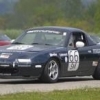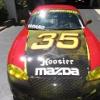When an oil pressure sensor starts to fail, how do they usually go? SPA Techniques sensor. Do they get erratic, die suddenly or can they stay linear but read lower than normal? Last time at track I noticed the pressure was lower than normal, by about 10-15 psi, when running down a long straight. Oil is fairly light, Driven XP1, but I've run it before. Oil filter was new to me, but hard to believe it would be restrictive enough to lower pressure, but guess it's possible. Engine is a new rebuild with about 10 hrs on it now.

#1

 Posted 07-31-2016 10:10 AM
Posted 07-31-2016 10:10 AM

Chris
Happiness is a dry martini and a good woman ... or a bad woman.
- George Burns
#2

 Posted 07-31-2016 10:57 AM
Posted 07-31-2016 10:57 AM

You'll get a few opinions on this. I have had one instance for sure where an oil filter caused a low oil pressure situation. Years ago I had similar low oil pressure due to a bearing or two wearing in the bottom end. It was not hard to diagnose. I drained oil into a wide shallow pan and put the pan in bright sunlight and you could see the shimmering metal particles floating on top. I knew right then and there what was the problem. You can also cut open your oil filter and look for metal. Changing sending unit and probably the gauge if you don't have a data system may be a good idea. If you can get to a dyno where you can get oil hot and check pressure before and/or after checking some of this out you should be able to determine if you have the problem solved or not.
I've used XP1 oil as well and when oil temp gets a little hotter than normal such as on a very hot day and when water temp is also a bit elevated, the decline in oil pressure was only 3-4PSI from "normal".




#3

 Posted 07-31-2016 11:34 AM
Posted 07-31-2016 11:34 AM

After checking thoughts per Tom, if you haven't found the issue procure a mechanical pressure gauge and plum the gauge so you can see while driving. Compare to your existing gauge.
I'm a mechanical gauge guy if available.
- chris haldeman and MPR22 like this



#4

 Posted 08-01-2016 06:52 AM
Posted 08-01-2016 06:52 AM

I never assume the sensor is failing...it has always been something else for me. I've witnessed a faulty filter blow up an engine once, similar pressure gauge "symptoms" ![]()
- Jim Drago likes this

#5

 Posted 08-01-2016 08:49 AM
Posted 08-01-2016 08:49 AM

How does a filter become faulty? Would this be to much flow or not enough? Does the stock pressure gauge read after or before the filter?
Ron
RAmotorsports


#6

 Posted 08-01-2016 09:58 AM
Posted 08-01-2016 09:58 AM

Well, a gauge dealer said failing sensors generally read either 0, Max or eradically, mine linear but low.. ![]() I haven't cut open the oil filter to check it, as I don't have the tool. Guess I should get one. I've moved back to one of my usual oil filters, but haven't started the engine since the oil change. Cold oil pressures at low neighborhood RPMs won't tell me much, so may need to get on the dyno and check things before heading to my next event.
I haven't cut open the oil filter to check it, as I don't have the tool. Guess I should get one. I've moved back to one of my usual oil filters, but haven't started the engine since the oil change. Cold oil pressures at low neighborhood RPMs won't tell me much, so may need to get on the dyno and check things before heading to my next event.
Chris
Happiness is a dry martini and a good woman ... or a bad woman.
- George Burns
#7

 Posted 08-01-2016 10:00 AM
Posted 08-01-2016 10:00 AM

How does a filter become faulty? Would this be to much flow or not enough? Does the stock pressure gauge read after or before the filter?
If memory serves, the sensor is after the filter.
Chris
Happiness is a dry martini and a good woman ... or a bad woman.
- George Burns
#8

 Posted 08-01-2016 10:20 AM
Posted 08-01-2016 10:20 AM

Chris, for a few $ you could procure an adjustable pressure switch, a red light and a green light, some wire and you have a warning system IMHJ better than waiting until free and looking a gauge. I have an AutoMeter mechanical gauge for oil pressure and water pressure, added adjustable pressure switches and lights for both and they work great. Could look and give you the exact mfg. and model number.
Less than $100.00 complete for both.
- av8tor likes this



#9

 Posted 08-01-2016 10:56 AM
Posted 08-01-2016 10:56 AM

It was a Fram filter, which had a faulty internal check valve, and the engine blew up the next practice day. Not sure if all filters have internal check valves or not.

#10

 Posted 08-01-2016 10:57 AM
Posted 08-01-2016 10:57 AM

Another option is something like:
http://www.autometer...uges/elite.html
Gives you a gauge and hi/low warning light all in one. Plus peak value recall and the ability to send 0-5v out to a data logger.
I have them for oil pressure & water temp. The warning feature is great.
#11

 Posted 08-01-2016 11:46 AM
Posted 08-01-2016 11:46 AM

Chris
Happiness is a dry martini and a good woman ... or a bad woman.
- George Burns
#12

 Posted 08-01-2016 01:21 PM
Posted 08-01-2016 01:21 PM

The SPA gauge has a settable warning light with an auxiliary LED on the dash. Default warning pressure is 25psi. Once at temp I was seeing 38 at roughly 6k in 4th. Usually see 52-57, maybe 48 on a hot day, however memory is fuzzy on that.
38 PSI with XP1 oil on a warm day in a pro built engine with slightly looser than factory bearing clearances is about what I have seen in 4 different engines. 37-40PSI very typical with that weight oil. Any chance you were running a higher viscosity oil previously?




#13

 Posted 08-01-2016 02:27 PM
Posted 08-01-2016 02:27 PM

2 parts to this post:
First on Gauges, we use and sell the Longacre stepper motor gauges. They have a programable warning system built in. Step one, the LED comes on, Step 2, the Needle flashes and step 3 (your wallet gets lighter) the entire gauge flashes at you. The water temp only has a 2 step system. I have been using these for several years and have been very happy with them.
Second on oil, All oil is dead dinosaurs. Synthetic oil has taken the different size oil molecules and separated them by size. Some are basketball size some are baseball size, and some are golf ball size. Imagine a mixture of these balls on your office floor. Then put a piece of plywood over the top. Only the basketballs are doing any work. Think of this inside your engine. Now imagine your engine bearing clearances as different sizes of balls. If your engine is built with tight clearances you can use smaller golf ball sized oil molecules. But try forcing the basketball sized molecules into a golf ball sized gap. Takes a lot of energy/horsepower to compress that basketball to fit in the golf ball gap. Now Imagine using golf ball molecules with basketball clearances. Everything starts to do a death rattle for a short period of time. Matching the right size molecule to fit with your bearing clearance can be very important in either direction. Too thick (large balls) of an oil costs you power. Too thin (small balls) of an oil costs you oil pressure and then motors. So what do you want? My experience is 40 psi on track at 6500 rpm at the end of the session is the prefered balance of power to longevity. More oil pressure is great for the engine if you are more budget conscience. VVT motors seem to like about 45psi. You have to know what your oil pressure actually is. The oem gauges do not give you a number. You also need to know what oil brand you plan to run. Driven is nice with their numbering system, 1 for thin 8 for thick. I prefer Redline with their 10-20-30-40 numbering system.
Oil does not break down. The additive package does. This is why I highly recommend a "RACE" oil rather than street oil of any kind. With age, the additives break down and the oil pressure starts to go down a little bit. Changing the oil will probably bring it back up.
This is another one of those small differences that add up in a "Fully Prepped" car. The hours spent on a dyno are not just about testing engines. You need to look at all the other components of the car and of the engine.
Dave
- David L, Alberto, steveracer and 2 others like this
Dave Wheeler
Advanced Autosports, the nations most complete Spec Miata shop
Author, Spec Miata Constructors Guide, version 1 and 2.0
Building Championship winning cars since 1995
4 time Central Division Spec Miata Champion car builder 2012-2013-2014-2017
Back to Back June Sprints Spec Miata 1-2 finishes 2016 and 2017
5 time June Sprints winner in Mazda's
6 Time Northern Conference Champion Car Builder
2014 SCCA Majors National point Champion car builder
2014 SCCA Runoffs winner, T4 (Bender)
2014 Central Division Champion, ITS (Wheeler)
2013 Thunderhill 25 hour winning crew chief
2007 June Sprints winner, (GT1, Mohrhauser)
Over 200 race wins and counting.
www.advanced-autosports.com
dave@advanced-autosports.com
608-313-1230





#14

 Posted 08-01-2016 02:45 PM
Posted 08-01-2016 02:45 PM

Speedway has a nice one
,http://www.speedwaym...utter,2618.html
- MotoFusi likes this
Frank
TnT Racing
SCCA Ohio Valley Region




#15

 Posted 08-01-2016 03:15 PM
Posted 08-01-2016 03:15 PM

Dave is correct as usual about oil.
Fram filters are crap, I only use them if no other option is available. The Yugo of filtration.
Ehaust tubing cutters work well also and are usually pretty cheap.
Steven Holloway
Artist formerly known as Chief Whipping Boy for Lone Star Region


#16

 Posted 08-01-2016 09:41 PM
Posted 08-01-2016 09:41 PM

38 PSI with XP1 oil on a warm day in a pro built engine with slightly looser than factory bearing clearances is about what I have seen in 4 different engines. 37-40PSI very typical with that weight oil. Any chance you were running a higher viscosity oil previously?
Thanks Tom & Dave, this is the first pro built engine I've had, so part of this maybe learning what is "normal" with this engine. Previously I've run Mobil-1 0-40 (too heavy) and Redline 30w. I had a case of the XP1 given to me to try out and was concerned the XP1 was too thin, but I'm certain I've saw less metallic sheen draining out of the filter than when I used Redline. So maybe the pressure I'm see with this engine is on target..? Now this was on an 80F day and water temps only hit 183F. So on a HOT day would something a tad heavier be needed?
Chris
Happiness is a dry martini and a good woman ... or a bad woman.
- George Burns
#17

 Posted 08-01-2016 09:43 PM
Posted 08-01-2016 09:43 PM

Everyone should have a filter cutter, checking with every oil change.
Speedway has a nice one
,http://www.speedwaym...utter,2618.html
Thank Frank. Price is fair too!
Chris
Happiness is a dry martini and a good woman ... or a bad woman.
- George Burns
#18

 Posted 08-02-2016 03:17 AM
Posted 08-02-2016 03:17 AM

2 parts to this post:
My experience is 40 psi on track at 6500 rpm at the end of the session is the preferred balance of power to longevity. More oil pressure is great for the engine if you are more budget conscience. VVT motors seem to like about 45psi. You have to know what your oil pressure actually is.
Dave so in essence the most important number is what the pressure is at 6500 rpm at the end of the race regardless of what the pressure is at idle?
I have a engine that originally came with the car and it was freshened(VVT) up however the oil pressure is way lower than my 100% VVT motor built by SAC.
On the original motor I see 40+PSI when its cold and idling when I come to the pits after a race its about 10PSI-15PSI idling, goes up to 30+ if I rev the engine.
What oil should I be using on that engine? I currently use 0-40 mobil 1 synthetic
Richard Astacio
2003 Spec Miata VVT & 2013 Cup Car



#19

 Posted 08-02-2016 05:36 AM
Posted 08-02-2016 05:36 AM

Dave so in essence the most important number is what the pressure is at 6500 rpm at the end of the race regardless of what the pressure is at idle?
I have a engine that originally came with the car and it was freshened(VVT) up however the oil pressure is way lower than my 100% VVT motor built by SAC.
On the original motor I see 40+PSI when its cold and idling when I come to the pits after a race its about 10PSI-15PSI idling, goes up to 30+ if I rev the engine.
What oil should I be using on that engine? I currently use 0-40 mobil 1 synthetic
You should have this discussion with your motor builder, he will have a recommendation about oil viscosity and target oil oressure.
- Brandon likes this
Frank
TnT Racing
SCCA Ohio Valley Region




#20

 Posted 08-02-2016 07:11 AM
Posted 08-02-2016 07:11 AM

Thanks Tom & Dave, this is the first pro built engine I've had, so part of this maybe learning what is "normal" with this engine. Previously I've run Mobil-1 0-40 (too heavy) and Redline 30w. I had a case of the XP1 given to me to try out and was concerned the XP1 was too thin, but I'm certain I've saw less metallic sheen draining out of the filter than when I used Redline. So maybe the pressure I'm see with this engine is on target..? Now this was on an 80F day and water temps only hit 183F. So on a HOT day would something a tad heavier be needed?
You should get a recommendation from the engine builder. My guess is they will recommend a bit more viscosity/pressure. Joe Gibbs/Driven used to publish a blending chart and I recall blending some XP3 with XP1 to get the pressure to 40+ PSI hot engine temps and hot weather days. If you want to keep using the XP1 you could drain about a quart or quart-and-a-half from the engine and add a quart of XP3 and you'll see an increase in pressure. This assumes any questions about the gauge or filter or other issues are answered but from what you said, it sounds like the recent oil viscosity change is the variable.




7 user(s) are reading this topic
0 members, 7 guests, 0 anonymous users




 Sign In
Sign In Create Account
Create Account



 Back to top
Back to top Report
Report









